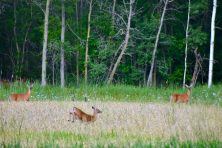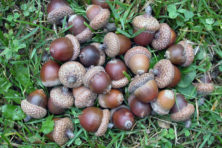Wild Things: Young Guns Get Early Shot at Abundant Whitetails
- Share
- Tweet
- Pin
- Share
Blaze orange will join the fiery reds, brilliant yellows, glowing greens and rusty browns of autumn this weekend during Wisconsin’s annual youth gun deer hunt. It’s a chance for licensed hunters age 15 and younger to get an early shot at some venison – and valuable hunting experience – under the watchful eye of an experienced mentor.
As a reminder, most hunters are under the blaze clothing requirements during any gun deer season. The only exception is for those who are after waterfowl.
Both resident and nonresident youths are eligible to hunt deer Oct. 10-11. The bag limit is one buck with a gun buck deer harvest authorization, plus additional antlerless deer valid for the county and land type (public access or private).
The youths must be mentored by a parent, guardian or other adult who has received permission from the hunter’s parent or guardian. For hunters younger than 12 and those who have not yet completed hunter education, the mentor must also be a hunter-education graduate and hold a current hunting license.
Adults accompanying youth hunters may possess a bow, crossbow or gun to hunt for a game species that is open at that time, including deer with a bow or crossbow only.
An adult may not accompany more than two youth hunters during the youth gun deer hunt at any given time, and those being mentored must be within an arm’s reach at all times. Youths age 11 and younger must have one-to-one mentoring.
Mentors are encouraged to review the four basic rules of firearm safety with the youth under their tutelage prior to hunting:
• Treat every gun as if it were loaded.
• Always point the muzzle in a safe direction.
• Be sure of your target and beyond.
• Keep your finger out of the trigger guard until you’re ready to shoot.
Although shooting accidents are rare, injuries involving tree stands are not. Hunters and mentors should check established stands for wear, fatigue, and loose nuts or bolts. The use of a full-body safety harness and tree-stand safety rope/haul line is recommended.
Because most falls occur when ascending or descending, be sure to maintain three points of contact (two hands and one foot, or two feet and one hand) at all times. Boots with nonslip soles are best.
The Show Must Go On?
COVID-19 concerns forced cancellations of dozens of state and national sport shows this year, and with no end to the pandemic in sight, one has to wonder how many will fold if they can’t make a go of it in 2021.
There are some signs of life, however, from some of the biggest in the business: Both the Archery Trade Association (ATA) and National Shooting Sports Foundation plan to move forward with their shows. The ATA Show is scheduled for Jan. 7-9 in Indianapolis, and the Shooting, Hunting and Outdoor Trade (SHOT) Show is planned for Jan. 19-22 in Las Vegas.
The American Sportfishing Association’s ICAST show in July was a virtual one, and much was learned about the ability to showcase the latest tackle online.
If they do go forward, the 2021 ATA and SHOT Shows will still likely look different than they have in the past. You’ll likely see mask mandates and other safety protocols, larger aisles with one-way traffic, and social-distancing efforts when and where possible.
There’s no official word yet on the many popular Wisconsin deer, turkey and fishing shows. Though dates are available online, it’ll likely be a while before we learn just which ones are going to take a chance.
Adopt a Dumpster or CWD Kiosk
With expanded CWD testing in our region comes a new opportunity in Door and Kewaunee counties this fall: a chance for individuals or groups to adopt a dumpster or CWD kiosk.
The main goal of the dumpster program is to provide hunters with an option for appropriate deer-carcass waste disposal, especially in areas where carcass disposal options are limited or not already available.
Meanwhile, the kiosks are set up as a 24/7, self-service option for dropping off deer heads (with a length of the neck) to be tested for CWD. A head may be taken to a kiosk up to five days after harvest if it’s been kept cool, or longer if it’s been frozen.
Individuals or organizations can sign up and volunteer to sponsor a kiosk throughout the deer season at a location that’s been agreed upon with the DNR. The main goal is to enhance CWD sample numbers and add ease and options for hunters.
Learn more about sponsoring by contacting DNR wildlife biologist Curt Rollman at [email protected] or 715.369.9399.
Weekly Water Levels
As of Oct. 2, Lake Michigan was down four inches from early September and is expected to drop another four inches by early November.
Lake levels were 33 inches above the long-term monthly average but eight inches below the record monthly high, set in 1986. Water levels were 63 inches above the record low, set in 1964.



